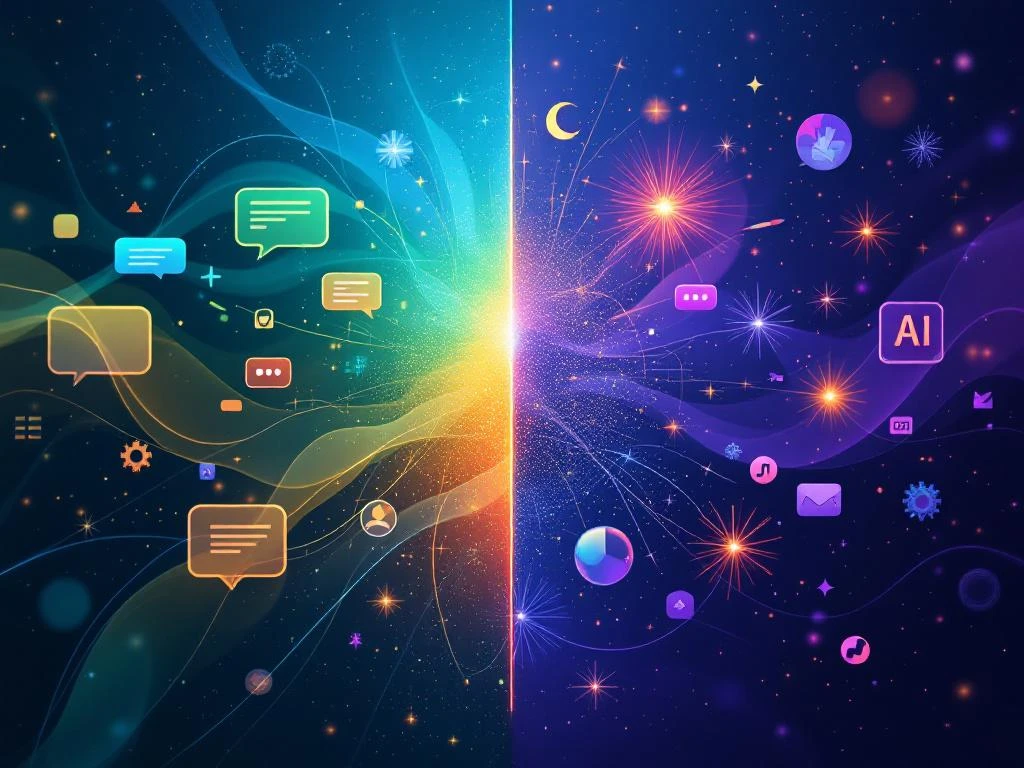Conversational AI and generative AI serve different purposes in the artificial intelligence landscape. Conversational AI specialises in dialogue and interaction, managing back-and-forth communication through chatbots and virtual assistants. Generative AI creates new content from learned patterns, producing text, images, or other media. Both technologies are transforming how businesses interact with customers and create content, but understanding their distinct capabilities helps you choose the right solution for your specific needs.
What is conversational AI and how does it work?
Conversational AI is technology designed to simulate human-like dialogue through natural language processing and understanding. It powers chatbots, virtual assistants, and customer service platforms that can engage in real-time conversations with users.
The core components of conversational AI include natural language processing (NLP), which breaks down and understands human speech or text, and natural language understanding (NLU), which interprets the intent behind user messages. These systems also incorporate dialogue management to maintain context throughout conversations and response generation to provide relevant replies.
When you interact with conversational AI, the system processes your input by analysing the words, identifying your intent, and accessing its knowledge base to formulate an appropriate response. Modern conversational AI can handle complex queries, remember previous parts of the conversation, and even transfer discussions to human agents when needed.
The technology excels in structured interactions where maintaining dialogue flow is crucial. This makes it particularly valuable for customer support, booking systems, and any application where users expect responsive, interactive communication.
What is generative AI and what makes it different?
Generative AI creates entirely new content by learning patterns from vast amounts of training data. Unlike systems that simply retrieve existing information, generative AI produces original text, images, code, or other content based on prompts and learned relationships.
The fundamental mechanism behind generative AI involves training large language models on massive datasets to understand patterns, relationships, and structures in content. When you provide a prompt, the system uses these learned patterns to generate new content that didn’t exist before but follows logical rules and contextual appropriateness.
What distinguishes generative AI from other AI approaches is its creative capability. Rather than following pre-programmed responses or retrieving existing answers, it synthesises information to produce something new. This includes writing articles, creating marketing copy, generating code, or even producing visual content.
Generative AI works particularly well for content creation tasks where originality and adaptability are important. It can adjust tone, style, and format based on your requirements whilst maintaining coherence and relevance to the topic at hand.
What’s the main difference between conversational AI and generative AI?
The primary difference lies in their core functions: conversational AI focuses on managing dialogue and interaction, while generative AI concentrates on creating new content. Think of conversational AI as a skilled conversation partner and generative AI as a creative content producer.
Conversational AI operates through structured dialogue management, maintaining context across multiple exchanges and providing responses that keep conversations flowing naturally. For example, a customer service chatbot uses conversational AI to handle enquiries, escalate issues, and guide users through processes step by step.
Generative AI, on the other hand, takes prompts and creates original content. When you ask it to write a product description or explain a complex concept, it generates new text based on patterns it has learned, rather than selecting from pre-written responses.
The interaction patterns also differ significantly. Conversational AI excels in back-and-forth exchanges where understanding context and maintaining dialogue flow matters most. Generative AI shines when you need original content creation, whether that’s writing, brainstorming, or producing variations on existing themes.
This distinction becomes particularly important when considering conversational search, where users expect both interactive dialogue capabilities and the ability to generate comprehensive, original responses to complex queries.
Which type of AI is better for customer service applications?
Conversational AI typically performs better for traditional customer service scenarios because it’s specifically designed for structured dialogue management and maintaining context throughout support interactions.
Customer service requires consistent dialogue flow, the ability to understand customer intent, and seamless handoffs between topics or to human agents. Conversational AI systems excel at these tasks because they’re built to manage conversations, track customer history, and provide responses that feel natural and helpful.
These systems can handle common enquiries like order status, account information, and troubleshooting through structured conversation trees whilst maintaining context. They’re also better at recognising when a customer needs human assistance and can transfer conversations smoothly.
However, generative AI can enhance customer service when combined with conversational systems. It can help create more personalised responses, generate detailed explanations for complex issues, or produce customised solutions based on specific customer situations.
The choice depends on your service model. If you need consistent, structured support interactions, conversational AI is typically the better foundation. If you require more creative problem-solving or highly personalised responses, incorporating generative AI capabilities alongside conversational systems often yields the best results.
Can conversational AI and generative AI work together?
Yes, conversational AI and generative AI can work together effectively, and many modern AI systems combine both technologies to create more powerful and flexible solutions.
Hybrid systems use conversational AI for dialogue management and user interaction whilst leveraging generative AI for content creation and response generation. This combination allows systems to maintain natural conversation flow whilst producing original, contextually appropriate responses rather than relying solely on pre-written scripts.
For example, a customer service system might use conversational AI to understand customer intent and manage the dialogue flow, then employ generative AI to create personalised responses based on the customer’s specific situation and history. This approach provides both structured interaction management and creative response generation.
In content creation workflows, conversational AI can guide users through requirements gathering and project planning, while generative AI handles the actual content production. This creates a more intuitive user experience where people can discuss their needs naturally before receiving generated content.
The benefits of combining both approaches include more natural interactions, greater flexibility in responses, and the ability to handle both routine queries and complex, unique situations effectively. This hybrid approach is becoming increasingly common as businesses seek AI solutions that can adapt to various scenarios whilst maintaining reliable performance.
How do you choose between conversational AI and generative AI for your business?
Your choice between conversational AI and generative AI should be based on your primary business objectives and the specific problems you’re trying to solve.
Choose conversational AI when your priority is managing customer interactions, providing structured support, or creating dialogue-based experiences. This includes customer service applications, booking systems, interactive troubleshooting, or any scenario where maintaining conversation context and managing dialogue flow is crucial.
Select generative AI when your main need is content creation, such as producing marketing materials, generating product descriptions, creating personalised communications, or developing original content at scale. Generative AI excels when creativity, originality, and content adaptation are your primary requirements.
Consider your implementation requirements as well. Conversational AI typically requires structured dialogue design and integration with existing customer service systems. Generative AI needs careful prompt engineering and content quality controls to ensure appropriate output.
Many businesses benefit from a combined approach, especially those dealing with both customer interaction needs and content creation requirements. A Knowledge Base system that can store your specific business information and industry expertise can enhance either approach, ensuring that whether you’re managing conversations or generating content, the AI draws from your verified, company-specific knowledge rather than generic training data.
The decision ultimately comes down to whether your primary challenge is managing interactions or creating content. Understanding this fundamental distinction helps you invest in the right technology for your specific business needs whilst building a foundation for future AI integration.






